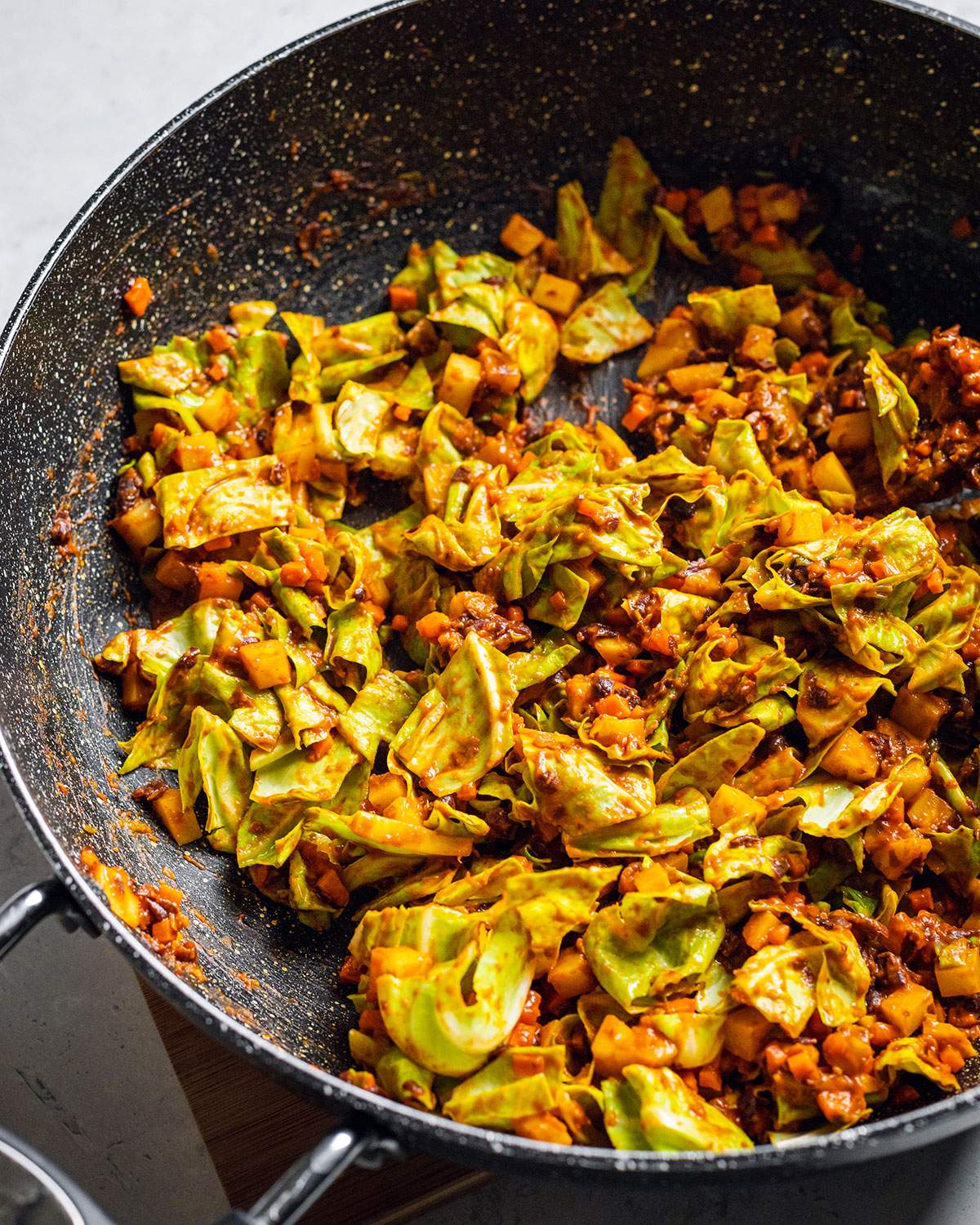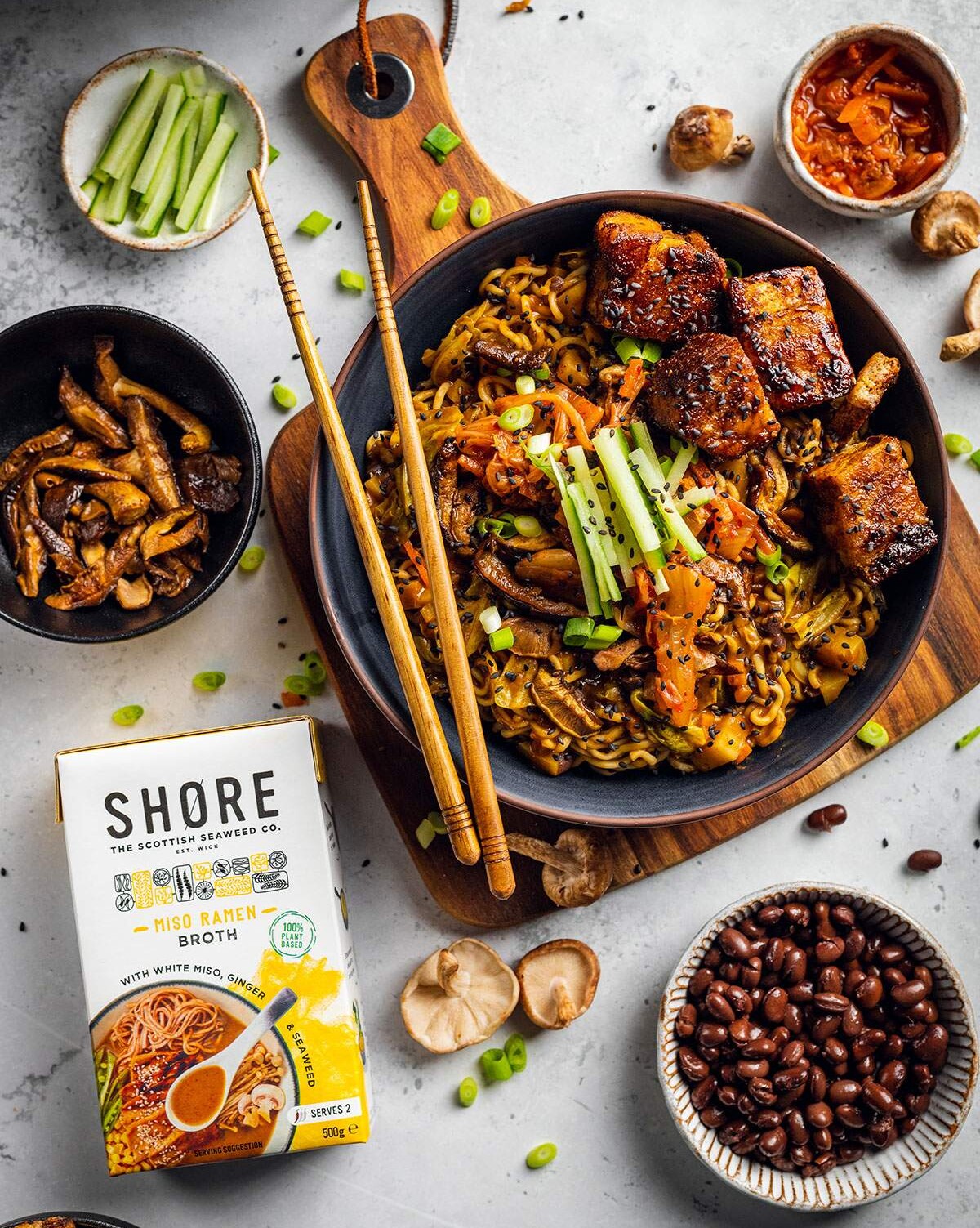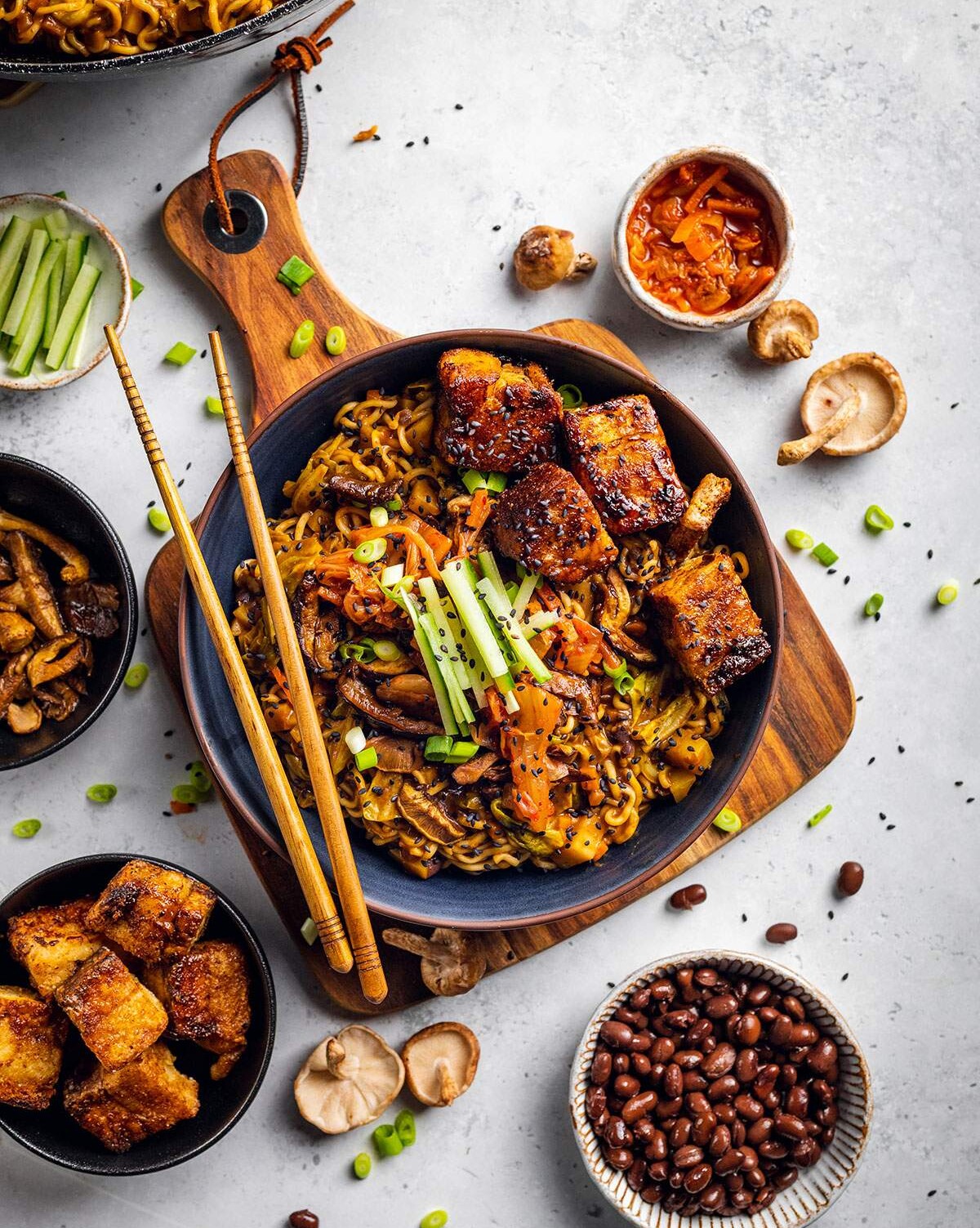This Vegan Black Bean Miso Ramen is a hearty and flavorful dish perfect to warm you up on a rainy day! And if you like to spice up your ramen recipes with bold flavors, then you’re in the right place.
For this flavorful ramen dish, the noodles are cooked in a savory black bean sauce made with precooked black beans and vegan miso broth, and served with cucumber and spicy kimchi as ramen toppings.
The sauce itself is packed with vegetables, such as diced potatoes, carrots, onions, and shiitake mushrooms, and it is made using Miso Broth from SHORE Seaweed, who are kindly sponsoring this blog post. Their ramen broth is an amazing product that can help you make delicious ramen in just a few minutes! You don't have to spend hours cooking to get that deep umami flavor that's essential for a great ramen. You can find SHORE ramen broths on Amazon right now, and they've have kindly offered an exclusive 15% off their Amazon store with the code 'Romyshore15' - so go ahead and try it out!

In this recipe blog post, we’re covering everything you need to know to make this comforting ramen dish at home - from ingredients and step-by-step instructions to serving suggestions, expert tips and more. Get ready to indulge in a bowl of comforting goodness!
Jump to:
If you're a noodle lover, you'll definitely want to give some of my favorite noodle recipes a try, such as these Peanut Noodles (my favorite recipe!) or this Tempeh Pad Thai! They are both fantastic staples to your regular dinner meals.
And I'm sure you'll also enjoy making these simple Vegan Summer Rolls - they are perfect for a hot summer day or also all year-round. Or simply drizzle some homemade Vegan Teriyaki Sauce onto your noodles for a quick & easy dish.
Who knows, these recipes might just become your new favorites!
❤️ What's to Love about This Recipe
This vegan ramen is incredibly easy to make! With just a few simple ingredients and some basic cooking techniques, you can create a delicious and satisfying meal in no time.
This ramen recipe is:
- Super easy to make!
- Packed with umami flavors
- Healthy and nutritious
- Vegetarian and vegan
- Including lots of interesting textures
- Easily adjustable - customize it to your liking by adding your favorite toppings or adjusting the level of spiciness.
- Using only basic cooking techniques
- Easy to make gluten-free
- Made with ingredients from my pantry, including SHORE Seaweed Miso Broth - which is a great staple if you love flavorful ramen soup without the hassle of making your own broth from scratch!
- Comforting and delicious, perfect for a cozy night in or a rainy day!
So, if you are looking for a comforting and delicious meal that is both healthy and easy to make, give this vegan black bean miso ramen recipe a try!
💭 What is Ramen?
Ramen (拉麺, ラーメン or らーめん, rāmen) is a popular Japanese dish that has taken the world by storm! It consists of a hearty and flavorful bowl of noodles, broth, and toppings. Traditionally, Chinese-style wheat noodles are used and it is often flavored with soy sauce or miso paste, and served with different toppings.
The history of ramen is pretty complex and varied, with many different versions of the dish originating in different regions of Japan. Some sources claim that the first form of ramen was brought to Japan by early Chinese immigrants in the late 1800s, while others suggest the dish originated during the Edo period (1603-1867).
Regardless of its origins, ramen has become an iconic dish in Japanese cuisine, and it continues to evolve and adapt with new ingredients and flavors. The dish has become increasingly popular and is now a staple in many restaurants worldwide.
The Inspiration for this Recipe
The recipe for this vegan black bean miso ramen was loosely inspired by the Korean-Chinese dish Jjajangmyeon (자장면) or Jjajangmyeon (짜장면), also known as korean black bean noodles.
It is traditionally enjoyed on special occasions, such as Black Day, a South Korean holiday to celebrate single people. This vegan black bean miso ramen is a tasty way to join in on the festivities! And if you're a fan of Korean dramas, this vegan version of the Korean noodle dish is sure to transport you to the streets of Seoul!
While traditionally made with pork belly and a thick, savory black bean sauce made with korean black bean paste, this version of a vegan jajangmyeon recipe swaps out the meat for shiitake mushrooms and adds an extra layer of umami flavor with the addition of a flavorful miso broth.
The result is a delicious and easy-to-make ramen recipe that's perfect for any night of the week!
🍜 Ingredients & Notes
Here's everything you need for this recipe:

- Noodles - The noodles are an essential part of any ramen dish! Traditionally, Chinese-style wheat noodles are used - they are typically thicker and chewier than egg noodles and are often also used in dishes like Chow Mein, Lo Mein and Dan Dan Noodles. For this vegan recipe, I like to use instant ramen noodles or udon noodles, as they are widely available in my area. You can use any type of ramen noodles you like best, including gluten-free noodles. For an even more authentic experience, consider using fresh noodles instead of dry wheat noodles.
- Vegetables - The vegetables used in this recipe are mushrooms, potatoes, scallions (green onions), carrots and cabbage. I love this combination as these veggies add a delicious variety of flavor and texture to the dish.
- Black Beans - Black beans add a rich and savory flavor to the dish. They are also a good source of protein and fiber, making this dish more filling and nutritious.
- Miso Broth - Miso broth is a staple in Japanese cuisine! It has a rich umami flavor and is often used as a base for soups and stews. In this recipe, I use SHORE Seaweed Miso Broth, which adds a deep and complex flavor to the dish.
- Gochujang Paste - Gochujang paste is a Korean chili paste that adds a spicy and slightly sweet flavor. It is an essential ingredient in many Korean dishes and is often used as a marinade or for dipping. In this recipe, gochujang adds a little spicy kick to the black bean sauce. Adjust the spiciness to your liking by adding more or less paste.
- Garnishes - The garnishes used in this recipe are finely sliced cucumber, kimchi, sesame seeds, and scallions. These garnishes add a fresh and crunchy texture and complement the richness of the sauce perfectly.
About SHORE Miso Ramen Broth
SHORE Miso Ramen is a delicious and fragrant plant-based ramen broth that is perfect for a quick and easy meal! Made with ginger, soy sauce, and authentic white Japanese miso, this dashi-style broth is layered with flavor and can be paired with your choice of noodles and toppings.
It's easy to prepare and can be heated up in just a few minutes, making it the perfect choice for a wholesome and tasty meal, such as this Vegan Black Bean Ramen!
SHORE also stock a delicious vegan Chilli Ramen Broth that packs a lot of umami flavors and a spicy kick. You can find a recipe using their chilli broth in the caption of my Instagram reel with SHORE.

Where to buy SHORE Miso Broth
SHORE Seaweed Miso Broth is available via their Amazon UK store and in many independent grocery stores around the UK.
SHORE have kindly sponsored this recipe blog post and offer an exclusive 15% off their Amazon store with the discount code 'Romyshore15' - so give it a try and enjoy a seriously tasty ramen in a matter of minutes!
Possible Ingredient Substitutions
In case you don't have everything to hand, here a few ideas and notes for possible substitutions:
- Noodles - This recipe works well with any type of noodles, so feel free to use the ones you like best!
- Vegetables - Use any vegetables you like in this recipe, such as carrots, zucchini, bell peppers, and broccoli.
- Cabbage - Use Napa cabbage, bok choy or savoy cabbage instead.
- Mushrooms - Swap shiitake mushrooms for button mushrooms or sliced portobello mushrooms.
- Soy Sauce - Use tamari instead of dark soy sauce - be aware that tamari has a stronger, saltier flavor than dark soy sauce, so you may need to adjust the amount used to taste.
- Cornstarch - Swap the cornstarch slurry for potato starch as a thickener for the black bean ramen sauce.
🥢 Equipment
Here's everything you need for this recipe:
- 1 Large wok or pan
- 1 Large skillet
- 1 Potato masher or large fork
- 1 small bowl
- 1 cutting board
- 1 Knife
- Measuring spoons
- Measuring cups
🔪 Recipe Instructions
Preparation
Prepare all your ingredients, then cook your ramen noodles according to their packaging instructions or until al dente, then rinse with water and set aside.
Step-by-Step

Cook the shiitake mushrooms in a dry skillet over medium heat & drizzle with tamari to crisp up the edges. Set aside.

Sauté spring onions, garlic, and ginger in sesame oil with sugar over high heat.

Add precooked black beans and mash in the skillet.

Add a little miso broth and gochujang paste.

Add potatoes and carrots, then cabbage and stir to coat.

Pour in the rest of the miso ramen broth, then add cornstarch slurry and stir until sauce thickens. Remove from heat.

Add cooked noodles to sauce and get ready to serve.

Garnish with julienned cucumbers, kimchi, sesame seeds and scallions and add vegan pork belly if you're feeling fancy.

👩👧👧 Serving
To serve, you have two options: you can add the cooked noodles to the sauce and coat them entirely, or you can place the noodles in a serving bowl and top them with the miso ramen sauce. Garnish with julienned cucumber, fermented kimchi, sesame seeds, and finely sliced scallions.
For an extra special touch, add some Vegan Pork Belly-Style Tofu, Vegan Chicken Pieces coated in Teriyaki Sauce or Sticky BBQ Tofu on top!
More Ramen Topping Ideas
Here are some more ideas of things you can add to ramen:
- Steamed broccoli
- Bean sprouts
- Scallions
- Nori Seaweed
- Pickled Radish
- Bok Choy
- Shichimi Togarashi
- Tofu crumbles
- Sweetcorn
- Sautéed mushrooms
And for an added authentic touch, try serving this vegan black bean miso ramen with a side of steamed dumplings from your favorite Chinese restaurant.


❄️ Storage
To store leftover ramen, keep the noodles and sauce in separate airtight containers. You can keep the noodles in the fridge for up to 3 days, and the sauce for up to 5 days.
How to reheat ramen in the microwave
Reheat the noodles and sauce separately in the microwave. First, heat the ramen broth until hot, then microwave the noodles for 1-2 minutes or until heated through, then pour the hot sauce over the noodles and serve.
💡 Tips & Tricks for Making the Best Black Bean Ramen
Here are some useful tips and tricks to help you make the perfect vegan black bean miso ramen:
- Noodles - After cooking, rinse the noodles under cold running water to remove excess starch. This will prevent them from becoming sticky and clumping together.
- Black Beans - Instead of mashing the beans with a potato masher or fork, you can also blend them in a food processor or use a stick blender to create a thick black bean sauce. Alternatively, you can use traditional Korean black bean paste for the recipe which you can find at Korean markets.
- Adjusting the Heat - Adjust the spiciness of the dish by adding more or less gochujang paste to suit your taste.
- Gluten-free Option - For a gluten-free option, use gluten-free ramen noodles and tamari instead of soya sauce.
- Flavor - For an added umami flavor, you can also add a spoonful of vegan oyster sauce to this dish.
How to Customize Ramen
If you want to shake things up, you can customize this ramen recipe with a few simple additions:
- Spicy Miso Ramen - Add 1-2 tablespoons of gochujang to the recipe or simply serve the ramen with a drizzle of chili oil and a sprinkle or red pepper flakes for extra heat. You can also swap the miso broth for SHORE Chilli Ramen Broth which packs a wonderful spicy punch with lots of umami!
- Tofu Ramen - Instead of topping the ramen with kimchi and cucumber, add Vegan Pork Belly-Style Tofu or Sticky BBQ Tofu alongside sliced scallions.
- Vegan Mushroom Ramen - Swap out the veggies for different types of mushrooms, such as shiitake and oyster mushrooms. In addition, sauté a few of them in a skillet until golden brown and crispy and use them as a topping for your ramen.
- Vegan Chicken Ramen - For a extra texture, add homemade vegan chicken pieces! Pan-fry them in a little gochujang or teriyaki sauce until sticky and lightly caramelized and serve them on top of the dish.

❓Frequently Asked Questions
Ramen noodles are usually vegan as they are traditionally made from wheat flour Depending on the brand and flavor, some packs of instant ramen contain animal products in the flavor sachet such as chicken or beef broth, but the dry instant noodles themselves are typically (accidentally) vegan.
If you are vegan or vegetarian, it's always best to check the ingredients list in more detail.
To make ramen less spicy, you can reduce or omit the amount of gochujang paste in this particular recipe. If your ramen dish is already too spicy, you can add more broth to the recipe to dilute the spiciness. You can also add some sugar or maple syrup to balance our the spiciness.
To store leftovers, keep the noodles and sauce separate. Store the noodles in an airtight container in the fridge for up to 3 days, and the sauce for up to 5 days.
To reheat, microwave the noodles and sauce separately and then mix them together.
Ramen can last for up to 5 days in the refrigerator if stored properly in an airtight container. For best results, store ramen noodles and sauce or broth separately, and only keep the noodles for up to 3 days.
To reheat ramen in the microwave, transfer the noodles and sauce to separate microwave-safe bowls. Cover sauce bowl with a microwave-safe lid or plastic wrap to prevent splatters and heat on high for 1-2 minutes, or until heated through, then stir and set aside.
Next, heat the noodles in the microwave for 1-2 minutes, or until heated, then pour the sauce over the noodles and stir before serving.
I wouldn't recommend freezing ramen noodles as they can become mushy when thawed. If you have already frozen your noodles, you can try the following steps:
Step 1 - Bring a pot of water to a boil.
Step 2 - Add the frozen noodles to the boiling water.
Step 3 - Bring the water back to a boil and cook the noodles for 1-2 minutes or until they are heated through and soft.
Step 4 - Drain the noodles and rinse them under cold water to stop the cooking process.
However, you can easily freeze ramen broth - simply allow it to cool completely before transferring it to a freezer-safe container. Leave a little room at the top of the container for expansion, seal it tightly, and store it in the freezer. When you're ready to use the broth, thaw it in the fridge or at room temperature and then reheat it on the stove or in the microwave.
Other Recipes You Might Enjoy
- Miso Roasted Aubergine20 Minutes
- Tempeh Katsu Curry40 Minutes
- Vegan Sushi Burrito35 Minutes
- Spicy Swede Soup with Ginger30 Minutes
📌 If you love Pinterest you can pin any of the images to your boards!
📝 Recipe
📖 Recipe Card

Vegan Black Bean Miso Ramen
Equipment
- 1 Large wok or pan
- 1 large skillet
- 1 Potato masher or large fork
- 1 small bowl
- 1 cutting board
- 1 Knife
- Measuring spoons
- Measuring cups
Ingredients
- 9 oz dry wheat noodles (250g) about 4 servings
- 3 oz shiitake mushrooms (85g) sliced
- 2 tablespoons dark soy sauce
- 3 tablespoons sesame oil
- 5 scallions (spring onions) thinly sliced
- 4 garlic cloves grated or crushed
- 1 teaspoon fresh ginger grated
- 1 tablespoon brown sugar
- 5.3 oz canned or cooked black beans (150g) drained
- 17 oz miso broth (500ml) I used SHORE Seaweed Miso Broth
- 1 tablespoon gochujang paste
- 5.3 oz white potatoes (150g) peeled & diced
- 3.5 oz carrots (100g) peeled & finely diced
- 4 oz cabbage (110g) chopped
- 0.5 - 1 tablespoon brown sugar to taste
For garnish (optional)
- pickled radish or kimchi
- sesame seeds
- finely sliced cucumber cut julienne
- scallions (spring onions) finely sliced
Instructions
- Cook the noodles following the package instructions, then rinse them under cold running water to stop the cooking and remove excess starch. Set aside.
- Add the sliced shiitake mushrooms into a dry skillet over medium heat and cook for 2-3 minutes. They should start releasing their water into the skillet and then cook in their own water, but add a splash of water in case they are a little sticky. Stirring regularly, cook until the liquid is evaporated, then drizzle in the soya sauce and remove from the heat after 1 minute, or once the edges of the mushrooms begin to caramelize. Set aside.
- Heat a large wok or pan over high heat and add in the sesame oil. Add the sliced spring onions, garlic and ginger and sauté for 2 to 3 minutes or until the onions are tender. Sprinkle in the sugar and reduce the heat after 1 minute.
- Add the black beans and stir to coat them in the aromatics. Using a potato masher or a large fork, mash the beans into the pan. Make sure to wear kitchen gloves to keep your hands safe!
- Pour in roughly ¼ cup (60ml) of the miso broth alongside the gochujang paste and stir well.
- Add in the potatoes and carrots. Sauté for 3-4 minutes, then add the diced cabbage. Mix everything well to coat the vegetables, then pour in the remaining miso broth. Cover with a lid and bring to a light simmer for 5 minutes or until the potatoes and carrots are tender. Stir regularly to make sure the flavors have mixed with the miso ramen broth.
- Season to taste with brown sugar and soy sauce.
- Mix the corn starch and water in a small bowl until dissolved. Pour the slurry into the sauce, whilst stirring continuously, then reduce the heat further. Keep stirring until the sauce thickens.
- Adjust the texture of the sauce to your liking with a little water or broth, then remove from the heat.
- To serve, you can add the cooked noodles to the sauce and coat them entirely, or place the noodles into a serving bowl and top if with the miso ramen sauce.
- To garnish, top the noodles with cucumber, pickled radish, sesame seeds and scallions & if you’re feeling extra fancy, add some Vegan Pork Belly-Style Tofu on top!
Notes
- Sauce - The black bean sauce is key to this recipe! It should be thick and rich, so adjust the texture with extra miso broth or more cornstarch slurry, if you desire.
- Spicy - You can adjust the spiciness of the sauce by adding more or less gochujang paste.
- Gluten-free - For a gluten-free option, use gluten-free ramen noodles and tamari instead of soya sauce.
- Storage - To store leftover ramen, keep the noodles and sauce separate. Store the noodles in an airtight container in the fridge for up to 3 days and the sauce for up to 5 days.
- Reheating - When reheating, microwave the noodles for 1-2 minutes or until heated through, then pour the hot sauce over the noodles.
- Ramen Topping Ideas (Optional) - steamed broccoli, sliced avocado, nori seaweed, kimchi, pickled radish, bok choy, bean sprouts, and shichimi togarashi.
- The estimated calories per portion for this recipe is around 600 calories. However, the exact calorie count may vary depending on the specific brands and amounts of ingredients used.
Latest Recipes on the Blog
- Vegan Ladyfingers1 Hours 10 Minutes
- How To Tell If An Onion Is Bad
- Vegan Burrito Bowl50 Minutes
- Grilled Balsamic Peaches35 Minutes
© 2025 Romy London / Romina Callwitz | All images, videos, wordings and content are copyright protected and belong to Romina Callwitz. Please do not use any of my content without prior permission. If you wish to re-publish any (part of my) content, please get in touch via email. Thanks for your support!
*Disclosure: This page may contain affiliate links and sponsored links that earn me a small commission, at no additional cost to you. You can find more information in my Privacy Policy.














Cherry
I'm obsessed with ramen, and this looks ultra delicious, especially with the added tofu on top! Chef's kiss! Can't wait to try it 😍
romylondonuk
Thank you for the lovely review, Cherry! So glad to hear you’re enjoying the recipe ❤️